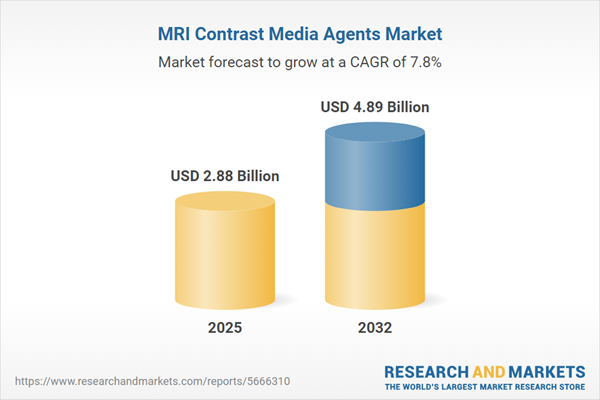Speak directly to the analyst to clarify any post sales queries you may have.
The MRI contrast media agents market is undergoing robust transformation as advanced imaging technologies and regulatory changes drive new standards for clinical precision and operational efficiency. Senior healthcare decision-makers face an evolving landscape where innovation, compliance, and competitive positioning intersect.
Market Snapshot: MRI Contrast Media Agents Market Size and Growth
The global MRI contrast media agents market grew from USD 2.67 billion in 2024 to USD 2.88 billion in 2025, charting a projected CAGR of 7.83% to reach USD 4.89 billion by 2032. This trajectory underscores rising demand for precision diagnostics, expanded clinical applications, and investments in safety-enhanced contrast formulations. Growth is propelled by the adoption of next-generation chelation chemistries, heightened diagnostic throughput, and regional market access dynamics. The market’s competitive environment features established pharmaceutical leaders and emerging biotechnology players focused on clinical efficacy and portfolio expansion.
MRI Contrast Media Agents Market: Scope & Segmentation
This research provides actionable intelligence on the foundational and emergent segments shaping the MRI contrast agents sector:
- Product Types: Ionic gadolinium-based agents (including linear and macrocyclic), non-ionic gadolinium formulations, iron-based agents, and manganese-based options.
- Agent Classes: Gadolinium, iron, and manganese-based compounds differentiated by chelation structure and safety profiles.
- Applications: Abdominal imaging (gastrointestinal, liver), cardiovascular imaging (cardiac, vascular), central nervous system, and musculoskeletal imaging.
- End Uses: Ambulatory surgical centers, diagnostic imaging centers, community and tertiary hospitals, and research institutes with high-field MRI systems.
- Distribution Channels: Direct sales, hospital pharmacies, online pharmacies, and retail pharmacies with distinct compliance requirements and logistics considerations.
- Administration Routes: Intravenous, oral, and intraarticular, each aligned with specific clinical objectives and protocols.
- Regional Coverage: Americas (US, Canada, Mexico, Brazil, Argentina, Chile, Colombia, Peru), Europe (UK, Germany, France, Russia, Italy, Spain, Netherlands, Sweden, Poland, Switzerland), Middle East (UAE, Saudi Arabia, Qatar, Turkey, Israel), Africa (South Africa, Nigeria, Egypt, Kenya), and Asia-Pacific (China, India, Japan, Australia, South Korea, Indonesia, Thailand, Malaysia, Singapore, Taiwan).
- Company Coverage: Profiles and comparative analysis on GE HealthCare Technologies Inc., Bracco Imaging S.p.A., Bayer AG, Guerbet SA, Lantheus Medical Imaging, Inc., Mallinckrodt plc, Fujifilm Holdings Corporation, Daiichi Sankyo Company, Limited, Jiangsu Hengrui Medicine Co., Ltd., and Sichuan Kelun Pharmaceutical Co., Ltd.
Key Takeaways: Strategic Insights for Decision-Makers
- Macrocyclic and non-gadolinium agents are gaining preference due to improved safety margins for vulnerable patient groups and enhanced kinetic stability.
- Technological collaboration, especially with imaging system vendors and informatics specialists, is unlocking co-developed solutions and workflow optimization.
- Regulatory scrutiny is shaping reformulated safety assessments and longer-term postmarketing surveillance requirements, reinforcing the value of real-world clinical evidence.
- Applications are broadening from neurology and cardiology into gastrointestinal, musculoskeletal, and oncology, reflecting a shift toward cross-disciplinary imaging protocols.
- Regional stakeholders prioritize different strategic levers: infrastructure development in Asia-Pacific, regulatory harmonization in EMEA, and specialty procedure growth in the Americas.
- Portfolio diversification and vertical integration are emerging among leading players to secure raw material supply and align with environmental standards.
Tariff Impact: Navigating 2025 U.S. Trade Policies
New US tariff measures in 2025 are triggering significant shifts across the MRI contrast media supply chain. Key industry actors are reviewing sourcing strategies, expanding supplier bases, and pursuing near-shoring for cost and risk mitigation. The evolving trade environment is accelerating localized production and deepening strategic alliances with regional contract manufacturers. Modernization in production and supply chain frameworks will be crucial to maintaining access, especially as global competitive dynamics adjust to new cost structures and procurement models.
Methodology & Data Sources
This report synthesizes primary data from structured interviews with market stakeholders, including executives, regulatory experts, and supply chain leaders. Secondary sources encompass peer-reviewed journals, regulatory and clinical trial databases, company reports, and industry conference proceedings. Rigorous cross-verification ensures the accuracy and relevance of insights.
Why This Report Matters for Senior Leaders
- Delivers a comprehensive view of technological innovation, regulatory changes, and commercial strategies shaping the MRI contrast media landscape.
- Equips decision-makers to prioritize supply chain resilience, sustainable manufacturing, and regional growth strategies in a shifting market.
- Supports strategic partnerships and investment planning with in-depth vendor, application, and regional performance analysis.
Conclusion
Senior leaders equipped with this analysis can anticipate shifts in technology, regulation, and regional growth levers to ensure sustained competitive advantage. Strategic alignment across operations, portfolio, and partnerships will be key drivers of future success in MRI contrast media markets.
Additional Product Information:
- Purchase of this report includes 1 year online access with quarterly updates.
- This report can be updated on request. Please contact our Customer Experience team using the Ask a Question widget on our website.
Table of Contents
3. Executive Summary
4. Market Overview
7. Cumulative Impact of Artificial Intelligence 2025
Companies Mentioned
The companies profiled in this MRI Contrast Media Agents market report include:- GE HealthCare Technologies Inc.
- Bracco Imaging S.p.A.
- Bayer AG
- Guerbet SA
- Lantheus Medical Imaging, Inc.
- Mallinckrodt plc
- Fujifilm Holdings Corporation
- Daiichi Sankyo Company, Limited
- Jiangsu Hengrui Medicine Co., Ltd.
- Sichuan Kelun Pharmaceutical Co., Ltd.
Table Information
| Report Attribute | Details |
|---|---|
| No. of Pages | 190 |
| Published | October 2025 |
| Forecast Period | 2025 - 2032 |
| Estimated Market Value ( USD | $ 2.88 Billion |
| Forecasted Market Value ( USD | $ 4.89 Billion |
| Compound Annual Growth Rate | 7.8% |
| Regions Covered | Global |
| No. of Companies Mentioned | 11 |









